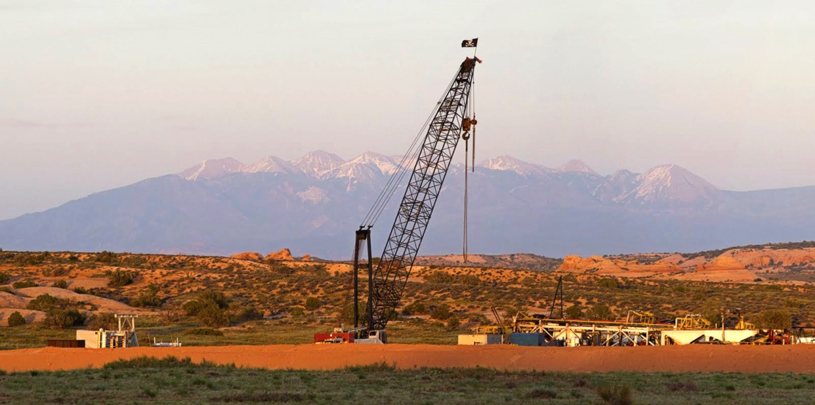

by Tim Peterson, Director of Utah Wildlands
Just outside Canyonlands National Park’s Island in the Sky district, oil has been a booming business since 2012 when Fidelity Exploration and Production brought in a gusher of an oil well. Fidelity built on their success by drilling more wells, and the resulting heavy truck traffic, pipeline construction, and proliferation of new drill pads on the doorstep of Canyonlands National Park and Deadhorse Point State Park has led some Moab locals to dub the area “Oil Land in the Sky.” For a time in 2012, Fidelity’s star well had the highest production in the continental United States at more than 1500 barrels per day, but with production declining dramatically, fracking the wells has apparently become Fidelity’s plan for maintaining profitability.
In a show of how quickly things can change in the volatile oil business, rosy reports of skyrocketing earnings and increasing production from Fidelity’s wells near Moab in February 2014 had been dashed by September, according to trade publication Natural Gas Intel Shale Daily: “I would say the results from the [new] wells [outside Canyonlands] were disappointing, and we realize we have to change our completion design to make those wells economical,” Fidelity CEO Kent Wells said.
The Paradox Basin, as the area where oil is found near Moab is known, represents a complex geology for oil production. Until Fidelity’s success in 2012, production in the area had been relatively weak. Deep salt beds made reliable production unpredictable, but Fidelity claimed to have cracked the code with their horizontal drilling methods, and their high production numbers seemed to prove it. On a field tour in 2013, a Fidelity representative who is no longer with the company told a group of stakeholders, the Trust among them, that the wells had not been hydraulically fractured (fracked) because salt deposits in the Paradox made the technique risky.
By September 2014, flagging production from both old and new well had changed Fidelity’s outlook according to Shale Daily: “We’ve been very fortunate [in this basin], we have never had to frack a well, which is kind of rare in today’s world. We have been able to use our natural completions, and get very good wells, but in the future I think we will need to make a shift to stimulate the wells to get the production we’re looking for.” Said Fidelity CEO Ken Wells, “Whether that is fracking or some other technique, we don’t know yet. We’ve been working on this for quite a while.”
Fidelity’s decision to frack the wells was confirmed by a filing made with the Securities and Exchange Commission on November 3, 2014 : “Recently drilled wells have yielded lower than expected results and include tighter rock than the previous drilled high rate wells. As a result, in November the company will test-fracture stimulation a well for the first time in the basin.” [emphasis added]
On November 3, MDU Resources Group, Fidelity’s parent company, announced that the Fidelity Exploration and Production arm of MDU was for sale. On November 7, more details on new fracking outside Canyonlands were published in Shale Daily: “The first fracking [in the oil field] is set for next week (Nov. 10-14), but these are not big massive fracks that we have to do in other places like the Powder River Basin or the Bakken,” Wells said. “We’re looking forward to doing that, and I am sure we’ll learn something on the first one, and we’ll probably look to do a second one shortly after that.’”
Locals report spotting fracking equipment bound for Island in the Sky late last week. Moabites are concerned about the potential impacts to water resources in the area – the oil field sits above the confluence of the Green and Colorado Rivers and the territory feeds Courthouse Wash, which flows east then north into Arches National Park. Locals would like the Bureau of Land Management and the National Park Service to study the potential impacts of fracking, but it appears the frack is already underway.
Adding to Fidelity’s operating costs and a liability on their leger, in 2013-14, the Bureau of Land Management required Fidelity to construct a costly and controversial natural gas gathering pipeline to capture natural gas produced at the oil wells instead of flaring (burning) it off at the well heads. Flaring not only wastes a non-renewable energy resource, it creates air quality problems. Some Moab locals are not satisfied with the as-yet-incomplete gas pipeline, citing construction quality and durability concerns in the popular recreation area of Big Flat, outside Canyonlands.
With most of Fidelity’s oil play located in part of the proposed Greater Canyonlands National Monument, we are left to wonder, is fracking oil wells in some of the most scenic redrock country in southeast Utah worth the potential risk to water and local communities? What will the company leave behind if and when their operation is sold and the oil runs dry? With flagging production and dim prospects, is the sacrifice of an internationally renowned scenic resource worth a few short years of oil production? We’ll keep you informed as the situation develops.
A rally in Salt Lake City followed by a spiritual walk in White Mesa demonstrate the Ute community's determination to see uranium mill close.
Read MoreArizona Governor Katie Hobbs is the latest elected official to call for an environmental review of Pinyon Plain uranium mine.
Read MoreHow does Colorado River water get divvied out to Colorado, Utah, Arizona, New Mexico, Nevada, California, Wyoming, Native American tribes, and Mexico?
Read More